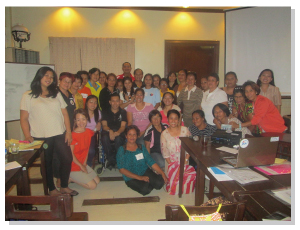- HOME
- Alumni News
- Activity Reports
- Orientation of Barangay Health Workers
Activity Reports
Orientation of Barangay Health Workers
Orientation for Barangay Health Workers on Profiling of Persons with Disabilities”
Corner Bistro, Jaro, Iloilo City on April 23, 2014
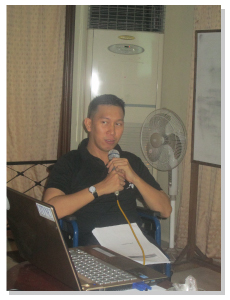
Last year between October and December, I met Mr. Jay Presnaldo of Community Based Adaptation and Resilience Against Disasters (CBARAD) that was supported by CITYNET Yokohama and Japanese International Cooperation Agency (JICA). This orientation project aims to raise the awareness, preparedness and responsiveness in the 5 selected Barangays (villages) in Iloilo City – namely, Buhang, Dungon A, Buntatala, San Isidro and Balabago. These Barangays (villages) are prone to floods. In fact, it was damaged greatly by the flood during the “Typhoon Frank” in June 2008 when most people living there evacuated and stayed in different “Evacuation Centers” in Jaro District. They had difficulty in getting potable water and food and were inaccessible to clean toilets. When JICA had their “Flood Control Project” they built some bridges that connected Iloilo City with nearby towns. Also, they widened the roads and highways and improved some “Drainage Systems” to reduce the flood level in the city and around.
In 2012 CITYNET Yokohama introduced Community Based Adaptation and Resilience Against Disasters (CBARAD) by selecting 5 Barangays for their Pilot Project. The Barangay Captains from these Barangays went to Japan to study the importance of preparedness and safety during disaster for about 2 weeks.
In December 2013, CBARAD held a seminar and workshop in Jaro Plaza Gym and Eon Centennial Hotel, Iloilo City. Ms. Blesilda Mabilog, my colleague in APCP and Team Leader and Consultant of Persons with Disabilities Affair Office (PDAO), also attended the events. In February 12, 2014, I attended the CBARAD consultation and workshop in Iloilo City Hall, where I learned the design of an accessible Evacuation Center, in case disasters and emergencies happen in the future. On March 21, 2014, Mr. Jay Presnaldo of CBARAD, Ms. Analyn V. Porras of the Association of Disabled Persons-Iloilo (ADP-I), Ms. Blesilda Mabilog and I had a meeting to create “Persons with Disabilities (PWDs) Profile Form” for the purpose of locating PWDs and to know the exact number of them residing in the 5 Pilot Barangays of CBARAD Project. I found this system very useful for gathering data to help Department of Health and Department of Social Welfare and Development that collect statistics about PWDs in the country including Iloilo City.
Subsequently on April 23, we held all-day-long program “Orientation for Barangay Health Workers on Profiling of PWDs.” The aim of this event was to make the civil servants of the Pilot Barangays to be aware to existence of PWDs in their area. Our target was especially set on Barangay Health Workers because they would do the actual profiling work. Mr. Jay Presnaldo had moved to Metro Manila before the event, so and Ms. Donna Magno replaced him.
During the program, Blesilda Mabilog gave a presentation on “DISABILITY AWARENESS CHECK” in a quiz form to assess the awareness level and knowledge of the participants about “Disability.” After the quiz I presented about “Kinds of Disabilities” and discussed there were 4 major categories:
- Physical
- Sensory
- Mental/Psychological/Emotional
- Intellectual
 |
 |
My presentation included all impairments and disorders that cause various disabilities such as:
- Learning Disabilities
- Communication/Speech and Language Disabilities
- Attention- Deficit Hyperactivity Disorder
- Autism spectrum Disorder
- Emotional Behavioral Disorder
- Intellectual and Developmental Disabilities
- Visual Impairment
- Hearing Impairment
- Physical/Orthopedic Impairment
- Multiple Disabilities
It took me for almost 2 hours (or half a day) to finish my discussion in the workshop. The participants were divided into 5 groups, each of which represented one disability.
1. Physical/Orthopedic Impairment
- Each participant was tied in hands and tried to write without using their hands
- Each participant sat in the wheelchair and tried to go upstairs
2. Hearing Impairment
- Each participant watched video with no sound and tried to guess what the people in the video talked about
3. Visual Impairment
- Each participant was blind folded and tried to follow the instructions for where to go or what to do
4. Emotional Behavioral Disturbance
- Each participant was asked to express her feelings or emotions instructed by the facilitator without any hesitations like anger, sorrow, and rage
5. Intellectual Disabilities
- Each participant had to read, count and write some foreign characters or must understand the child in the movie why he cannot read, count and write but he has no physical deformity when you look at him.
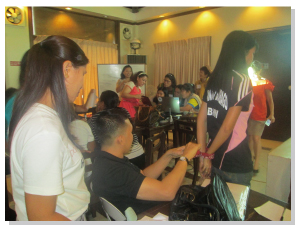 |
 |
After we finish the said workshop a representative of each group shared their experiences. Most of them said that life having disability was hard, sad and hurtful because you want to do something but you cannot do it because of impairment. Some of them reported they had felt ashamed to ask for help, and some had been very irritated and angry. But all of them agreed to respect each person regardless of a possession of disability.
After my lecture, Ms. Analyn Porras discussed Disability Equality Training (DET). She explained thoroughly the connection of the mind-set of the people and structures, which makes us “Disabled.” She also argued what duty the society has towards PWDs and conducted a workshop, where the participants were divided into 3 groups and asked to find many solutions to how to put the star into the box with a hole. Many of the participants enjoyed the challenge.
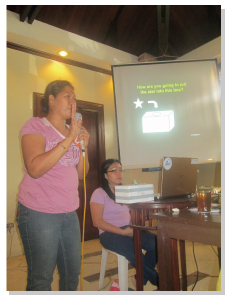 |
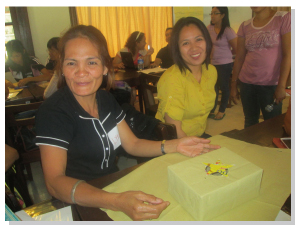 |
After that she discussed “How to Assist Persons with Disabilities,” elaborating on how to help blind persons, how to communicate with Deaf people and how to handle a wheelchair. She emphasized that respect to assistive devices was as important as respecting PWDs.
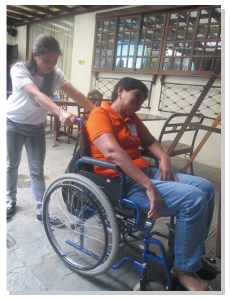
Then, Ms. Blesilda Mabilog gave a presentation entitled “Awareness and Definition of the following: Disability, Impairment, Handicapped and Disorder.” She linked her discussion to Magna Carta 7277 – Law for Persons with Disabilities – its amending law 9442 and the functions of PDAO. She also explained the “PWD Profile Form” to representatives of those Barangays who were present.
I became an advocate of PWDs in 2006 after I was trained as a Duskin Trainee. I must say my dream to study and present “All Kinds of Disabilities” in my own terms (or “Lay Men’s Term”) has come true, and this is a big honor. Creating such a “masterpiece” presentation is not easy, as you have to read a number of books to compare different theories and definitions and then make them easy to understand for everybody. It was such a great challenge that I thought I could not do. But, although it has taken a lot of time, patience and hard work, my eagerness to learn and wish to impart information to others has kept me going. We must LOVE ourselves in all aspects including our disability, so that we could understand not only ourselves but also others. Only after this, we can love our country and people by serving and giving them ourselves to return what God has given us. I know it is not easy to change society. But what is important is that we start on something good.
MARK F. ESPESOR
7th Duskin Trainee
Philippines
